Dihydropyrazole-Carbohydrazide Derivatives with Dual Activity as Antioxidant and Anti-Proliferative Drugs on Breast Cancer Targeting the HDAC6
Abstract
:1. Introduction
2. Results and Discussion
2.1. Design Features of Compounds 2a–i
2.2. Synthesis of DPCH Derivatives
2.3. Molecular Structure of Compound 2a
2.4. In Silico Studies
2.4.1. Docking Simulation
2.4.2. Evaluation of Physicochemical and Toxicobiological Properties
2.5. In Vitro Pharmacological Evaluation
2.5.1. Cell Viability Assays
2.5.2. Wound Closure Assays in the MDA-MB-231 BC Line
2.5.3. In Vitro HDAC6 Human Recombinant Inhibition
2.6. QSAR Analysis
2.7. Antioxidant Activity
3. Materials and Methods
3.1. Instrumental and Chemicals
3.2. X-ray Structure Determination
3.3. Chemical Synthesis of Substituted DPCH Derivatives 2a–i
3.4. Modelling and In Silico Studies
3.4.1. Docking Simulations
3.4.2. Theoretical ADME-Tox and Physicochemical Properties
3.4.3. QSAR Analysis
3.5. In Vitro Assays
3.5.1. Cell Culture
3.5.2. Cell Proliferation Assays
3.5.3. In Vitro HDAC6 Inhibition
3.5.4. Confocal Fluorescence Microscopy
3.5.5. Wound Closure Assay
3.5.6. DPPH Assay (2,2-Diphenyl-1-picrylhydrazyl)
3.6. Statistical Analysis
4. Conclusions
Supplementary Materials
Author Contributions
Funding
Institutional Review Board Statement
Informed Consent Statement
Data Availability Statement
Conflicts of Interest
References
- World Health Organization (WHO), Breast Cancer. 2021. Available online: https://www.who.int/news-room/fact-sheets/detail/breast-cancer (accessed on 24 January 2022).
- Bray, F.; Ferlay, J.; Soerjomataram, I.; Siegel, R.L.; Torre, L.A.; Jemal, A. Global Cancer Statistics: GLOBOCAN estimates of incidence and mortality worldwide for 36 cancers in 185 countries. CA Cancer J. Clin. 2018, 68, 394–424. [Google Scholar] [CrossRef] [PubMed] [Green Version]
- Claude-Taupin, A.; Boyer-Guittaut, M.; Delage-Mourroux, R.; Hervouet, E. Use of Epigenetic Modulators as a Powerful Adjuvant for Breast Cancer Therapies. In Cancer Epigenetics; Methods in Molecular Biology; Humana Press: New York, NY, USA, 2015; Volume 1238, pp. 487–509. [Google Scholar] [CrossRef]
- Perou, C.M.; Sorlie, T.; Eisen, M.B.; van de Rijn, M.; Jeffrey, S.S.; Rees, C.A.; Pollack, J.R.; Ross, D.T.; Johnsen, H.; Akslen, L.A.; et al. Molecular portraits of human breast tumours. Nature 2000, 406, 747–752. [Google Scholar] [CrossRef] [PubMed]
- Buocikova, V.; Rios-Mondragon, I.; Pilalis, E.; Chatziioannou, A.; Miklikova, S.; Mego, M.; Pajuste, K.; Rucins, M.; El-Yamani, N.; Longhin, E.M.; et al. Epigenetics in Breast Cancer Therapy—New Strategies and Future Nanomedicine Perspectives. Cancers 2020, 12, 3622. [Google Scholar] [CrossRef] [PubMed]
- Marks, D.L.; Olson, R.L.; Fernandez-Zapico, M.E. Epigenetic control of the tumor microenvironment. Epigenomics 2016, 8, 1671–1687. [Google Scholar] [CrossRef] [PubMed] [Green Version]
- Giacinti, L.; Claudio, P.P.; Lopez, M.; Giordano, A. Epigenetic information and estrogen receptor alpha expression in breast cancer. Oncologist 2006, 11, 1–8. [Google Scholar] [CrossRef] [Green Version]
- Sadoul, K.; Boyault, C.; Pabion, M.; Khochbin, S. Regulation of protein turnover by acetyltransferases and deacetylases. Biochimie 2008, 90, 306–312. [Google Scholar] [CrossRef]
- Dekker, F.J.; Haisma, H.J. Histone acetyl transferases as emerging drug targets. Drug Discov. Today 2009, 14, 942–948. [Google Scholar] [CrossRef]
- Grozinger, C.M.; Hassig, C.A.; Schreiber, S.L. Three proteins define a class of human histone deacetylases related to yeast Hda1p. Proc. Natl. Acad. Sci. USA 1999, 96, 4868–4873. [Google Scholar] [CrossRef] [Green Version]
- Marks, P.; Rifkind, R.A.; Richon, V.M.; Breslow, R.; Miller, T.; Kelly, W.K. Histone deacetylases and cancer: Causes and therapies. Nat. Rev. Cancer 2001, 1, 194–202. [Google Scholar] [CrossRef]
- Abel, T.; Zukin, R.S. Epigenetic targets of HDAC inhibition in neurodegenerative and psychiatric disorders. Curr. Opin. Pharmacol. 2008, 8, 57–64. [Google Scholar] [CrossRef] [Green Version]
- D’Mello, S.R. Histone deacetylases as targets for the treatment of human neurodegenerative diseases. Drug News Perspect. 2009, 22, 513–524. [Google Scholar] [CrossRef]
- Mottamal, M.; Zheng, S.; Huang, T.L.; Wang, G. Histone Deacetylase Inhibitors in Clinical Studies as Templates for New Anticancer Agents. Molecules 2015, 20, 3898–3941. [Google Scholar] [CrossRef] [Green Version]
- Bolden, J.E.; Peart, M.J.; Johnstone, R.W. Anticancer activities of histone deacetylase inhibitors. Nat. Rev. Drug Discov. 2006, 5, 769–784. [Google Scholar] [CrossRef]
- Shakespear, M.R.; Halili, M.A.; Irvine, K.M.; Fairlie, D.P.; Sweet, M.J. Histone deacetylases as regulators of inflammation and immunity. Trends Immunol. 2011, 32, 335–343. [Google Scholar] [CrossRef]
- Chuang, D.M.; Leng, Y.; Marinova, Z.; Kim, H.J.; Chiu, C.T. Multiple roles of HDAC inhibition in neurodegenerative conditions. Trends Neurosci. 2009, 32, 591–601. [Google Scholar] [CrossRef] [Green Version]
- Park, J.-H.; Jung, Y.; Kim, T.Y.; Kim, S.G.; Jong, H.-S.; Lee, J.W.; Kim, D.-K.; Lee, J.-S.; Kim, N.K.; Kim, T.-Y.; et al. Class I histone deacetylase-selective novel synthetic inhibitors potently inhibit human tumor proliferation. Clin. Cancer Res. 2004, 10, 5271–5281. [Google Scholar] [CrossRef] [Green Version]
- Zhang, Y.; Li, N.; Caron, C.; Matthias, G.; Hess, D.; Khochbin, S.; Matthias, P. HDAC-6 interacts with and deacetylates tubulin and microtubules in vivo. EMBO J. 2003, 22, 1168–1179. [Google Scholar] [CrossRef] [Green Version]
- Grozinger, C.M.; Schreiber, S.L. Deacetylase enzymes: Biological functions and the use of small-molecule inhibitors. Chem. Biol. 2002, 9, 3–16. [Google Scholar] [CrossRef] [Green Version]
- Carey, N.; La Thangue, N.B. Histone deacetylase inhibitors: Gathering pace. Curr. Opin. Pharmacol. 2006, 6, 369–375. [Google Scholar] [CrossRef]
- Bertrand, P. Inside HDAC with HDAC inhibitors. Eur. J. Med. Chem. 2010, 45, 2095–2116. [Google Scholar] [CrossRef]
- Zhang, Y.; Gilquin, B.; Khochbin, S.; Matthias, P. Two catalytic domains are required for protein deacetylation. J. Biol. Chem. 2006, 281, 2401–2404. [Google Scholar] [CrossRef] [PubMed] [Green Version]
- Zhang, X.; Yuan, Z.; Zhang, Y.; Yong, S.; Salas-Burgos, A.; Koomen, J.; Olashaw, N.; Parsons, J.T.; Yang, X.-J.; Dent, S.R.; et al. HDAC6 modulates cell motility by altering the acetylation level of cortactin. Mol. Cell 2007, 27, 197–213. [Google Scholar] [CrossRef] [PubMed] [Green Version]
- Aoyagi, S.; Archer, T.K. Modulating molecular chaperone Hsp90 functions through reversible acetylation. Trends Cell Biol. 2005, 15, 565–567. [Google Scholar] [CrossRef] [PubMed]
- Deakin, N.O.; Turner, C.E. Paxillin inhibits HDAC6 to regulate microtubule acetylation, Golgi structure and polarized migration. J. Cell Biol. 2014, 206, 395–413. [Google Scholar] [CrossRef] [Green Version]
- Kovacs, J.J.; Murphy, P.J.; Gaillard, S.; Zhao, X.; Wu, J.T.; Nicchita, C.V.; Yoshida, M.; Toft, D.O.; Pratt, W.B.; Yao, T.P. HDAC6 regulates Hsp90 acetylation and chaperone-dependent activation of glucocorticoid receptor. Mol. Cell 2005, 18, 601–607. [Google Scholar] [CrossRef]
- Zhang, Z.; Yamashita, H.; Toyama, T.; Sugiura, H.; Omoto, Y.; Ando, Y.; Mita, K.; Hamaguchi, M.; Hayashi, S.-I.; Iwase, H. HDAC6 expression is correlated with better survival in breast cancer. Clin. Cancer Res. 2004, 10, 6962–6968. [Google Scholar] [CrossRef] [Green Version]
- Seidel, C.; Schnekenburger, M.; Dicato, M.; Diederich, M. Histone deacetylase 6 in health and disease. Epigenomics 2015, 7, 103–118. [Google Scholar] [CrossRef] [Green Version]
- Roche, J.; Bertrand, P. Inside HDACs with more selective HDAC inhibitors. Eur. J. Med. Chem. 2016, 121, 451–483. [Google Scholar] [CrossRef]
- Zou, H.; Wu, Y.; Navre, M.; Sang, B.-C. Characterization of the two catalytic domains in histone deacetylase 6. Biochem. Biophys. Res. Commun. 2006, 341, 45–50. [Google Scholar] [CrossRef]
- Asthana, J.; Kapoor, S.; Mohan, R.; Panda, D. Inhibition of HDAC6 deacetylase activity increases its binding with microtubules and suppresses microtubule Dynamic instability in MCF-7 cells. J. Biol. Chem. 2013, 288, 22516–22526. [Google Scholar] [CrossRef] [Green Version]
- Matsuyama, A.; Shimazu, T.; Sumida, Y.; Saito, A.; Yoshimatsu, Y.; Seigneurin-Berny, D.; Osada, H.; Komatsu, Y.; Nishino, N.; Khochbin, S.; et al. In vivo destabilization of Dynamic microtubules by HDAC6 mediated deacetylation. EMBO J. 2002, 21, 6820–6831. [Google Scholar] [CrossRef] [Green Version]
- Dallavalle, S.; Pisano, C.; Zunino, F. Development and therapeutic impact of HDAC6-selective inhibitors. Biochem. Pharmacol. 2012, 84, 756–765. [Google Scholar] [CrossRef]
- Haggarty, S.J.; Koeller, K.M.; Wong, J.V.; Grozinger, C.M.; Schreiber, S.L. Domain-selective small-molecule inhibitor of histone deacetylase 6 (HDAC6)-mediated tubulin deacetylation. Proc. Natl. Acad. Sci. USA 2003, 100, 4389–4394. [Google Scholar] [CrossRef] [Green Version]
- Batchu, S.N.; Brijmohan, A.S.; Advani, A. The therapeutic hope for HDAC6 inhibitors in malignancy and chronic disease. Clin. Sci. 2016, 130, 987–1003. [Google Scholar] [CrossRef]
- Halliwell, B.; Gutteridge, J.M.C. Chapter 5 Oxidative Stress and Redox Regulation: Adaptation, Damage, Repair, Senescence and Death. In Free Radicals in Biology and Medicine, 5th ed.; Oxford University Press: Oxford, UK, 2015. [Google Scholar] [CrossRef]
- Ambrosone, C.B. Oxidants and Antioxidants in Breast Cancer. Antioxid. Redox Signal. 2000, 2, 903–917. [Google Scholar] [CrossRef]
- Shirwaikar, A.; Shirwaikar, A.; Rajendran, K.; Punitha, I.S.R. In Vitro Antioxidant Studies on the Benzyl Tetra Isoquinoline Alkaloid Berberine. Biol. Pharm. Bull. 2006, 29, 1906–1910. [Google Scholar] [CrossRef] [Green Version]
- Fleischauer, A.T.; Simonsen, N.; Arab, L. Antioxidant Supplements and Risk of Breast Cancer Recurrence and Breast Cancer-Related Mortality Among Postmenopausal Women. Nutr. Cancer 2003, 46, 15–22. [Google Scholar] [CrossRef]
- Greenlee, H.; Gammon, M.D.; Abrahamson, P.E.; Gaudet, M.M.; Terry, M.B.; Hershman, D.L.; Desai, M.; Teitelbaum, S.L.; Neugut, A.I.; Jacobson, J.S. Prevalence and Predictors of Antioxidant Supplement Use During Breast Cancer Treatment. Cancer 2009, 115, 3271–3282. [Google Scholar] [CrossRef] [Green Version]
- Fernandez-Lazaro, C.I.; Martínez-González, M.A.; Aguilera-Buenosvinos, I.; Gea, A.; Ruiz-Canela, M.; Romanos-Nanclares, A.; Toledo, E. Dietary Antioxidant Vitamins and Minerals and Breast Cancer Risk: Prospective Results from the SUN Cohort. Antioxidants 2021, 10, 340. [Google Scholar] [CrossRef]
- Goh, J.; Pettan-Brewer, C.; Enns, L.; Fatemie, S.; Ladiges, W. Are Exercise and Mitochondrial Antioxidants Compatible in the Treatment of Invasive Breast Cancer? Bioenergy Open Access 2012, 1, 101. [Google Scholar] [CrossRef] [Green Version]
- Kumar, M.R.; Dhayabaran, V.V.; Sudhapriya, N.; Manikandan, A.; Gideon, D.A.; Annapoorani, S. p-TSA.H2O mediated one-pot, multi-component synthesis of isatin derived imidazoles as dual-purpose drugs against inflammation and cancer. Bioorg. Chem. 2020, 102, 104046. [Google Scholar] [CrossRef]
- Harisha, S.; Keshavayya, J.; Prasanna, S.M.; Hoskeri, H.J. Synthesis, characterization, pharmacological evaluation and molecular docking studies of benzothiazole azo derivatives. J. Mol. Struct. 2020, 1218, 128477. [Google Scholar] [CrossRef]
- Chatterjee, A.; Ronghe, A.; Padhye, S.B.; Spade, D.A.; Bhat, N.K.; Bhat, H.K. Antioxidant activities of novel resveratrol analogs in breast cancer. J. Biochem. Mol. Toxicol. 2018, 32, e21925. [Google Scholar] [CrossRef] [PubMed]
- Sheu, M.-T.; Jhan, H.-J.; Hsieh, C.-M.; Wang, C.-J.; Ho, H.-O. Efficacy of Antioxidants as a Complementary and Alternative Medicine (CAM) in Combination with the Chemotherapeutic Agent Doxorubicin. Integr. Cancer Ther. 2015, 14, 184–195. [Google Scholar] [CrossRef] [PubMed]
- Chimenti, F.; Bolasco, A.; Manna, F.; Secci, D.; Chimenti, P.; Befani, O.; Turin, P.; Giovannini, V.; Mondovi, B.; Cirilli, R.; et al. Synthesis and selective inhibitory activity of 1-acetyl-3,5-diphenyl-4,5-dihydro-(1H)-pyrazole derivatives against monoamine oxidase. J. Med. Chem. 2004, 47, 2071–2074. [Google Scholar] [CrossRef]
- Girisha, K.S.; Kalluraya, B.; Narayana, V. Padmashree, Synthesis and pharmacological study of 1-acetyl/propil-3-aryl-5-(5-chloro-3-methyl-1-phenyl-1H-pyrazol-4-yl)-2-pyrazoline. Eur. J. Med. Chem. 2010, 45, 4640–4644. [Google Scholar] [CrossRef]
- Bao, H.; Zhang, Q.; Zhu, Z.; Xu, H.; Ding, F.; Wang, M.; Du, Y.; Yan, Z. BHX, a novel pyrazoline derivative, inhibits breast cancer cell invasion by reversing the epithelial mesenchymal transition and down-regulating Wnt/β-catenin signalling. Sci. Rep. 2017, 7, 9153. [Google Scholar] [CrossRef]
- Yan, Z.; Zhu, Z.; Wang, J.; Sun, J.; Chen, Y.; Yang, G.; Chen, W.; Deng, Y. Synthesis, characterization, and evaluation of a novel inhibitor of WNT/β-catenin signaling pathway. Mol. Cancer 2013, 12, 116. [Google Scholar] [CrossRef] [Green Version]
- Park, S.Y.; Jun, J.A.; Jeong, K.J.; Heo, H.J.; Sohn, J.S.; Lee, H.Y.; Park, C.G.; Kang, J. Histone deacetylases 1, 6 and 8 are critical for invasion in breast cancer. Oncol. Rep. 2011, 25, 1677–1681. [Google Scholar] [CrossRef] [Green Version]
- Butler, K.V.; Kalin, J.; Brochier, C.; Vistoli, G.; Langley, B.; Kozikowski, A.P. Rational Design and Simple Chemistry Yield a Superior, Neuroprotective HDAC6 Inhibitor, Tubastatin A. J. Am. Chem. Soc. 2010, 132, 10842–10846. [Google Scholar] [CrossRef] [Green Version]
- Osko, J.D.; Christianson, D.W. Structural determinants of affinity and selectivity in the binding of inhibitors to histone deacetylase 6. Bioorg. Med. Chem. Lett. 2020, 30, 127023. [Google Scholar] [CrossRef]
- Sixto-López, Y.; Gómez-Vidal, J.A.; de Pedro, N.; Bello, M.; Rosales-Hernández, M.C.; Correa-Basurto, J. Hydroxamic acid derivatives as HDAC1, HDAC6 and HDAC8 inhibitors with antiproliferative activity in cancer cell lines. Sci. Rep. 2020, 10, 10462. [Google Scholar] [CrossRef]
- Estiu, G.; Greenberg, E.; Harrison, C.B.; Kwiatkowski, N.P.; Mazitschek, R.; Bradner, J.E.; Wiest, O. Structural Origin of Selectivity in Class II-Selective Histone Deacetylase Inhibitors. J. Med. Chem. 2008, 51, 2898–2906. [Google Scholar] [CrossRef]
- Kerr, J.S.; Galloway, S.; Lagrutta, A.; Armstrong, M.; Miller, T.; Richon, V.M.; Andrews, P.A. Nonclinical safety assessment of the histone deacetylase inhibitor vorinostat. Int. J. Toxicol. 2010, 29, 3–19. [Google Scholar] [CrossRef]
- Shen, S.; Kozikowski, A.P. Why Hydroxamates May Not Be the Best Histone Deacetylase Inhibitors—What Some May Have Forgotten or Would Rather Forget? ChemMedChem 2016, 11, 15–21. [Google Scholar] [CrossRef] [Green Version]
- Padilla-Martínez, I.I.; Flores-Larios, I.Y.; García-Báez, E.V.; González, J.; Cruz, A.; Martínez-Martínez, F.J. X-ray Supramolecular structure, NMR spectroscopy and synthesis of 3-methyl-1-phenyl-1H-chromeno [4,3-c]pyrazol-4-ones formed by the unexpected cyclization of 3-[1-(phenyl-hydrazono)ethyl]–chromen-2-ones. Molecules 2011, 16, 915–932. [Google Scholar] [CrossRef] [Green Version]
- Groom, C.R.; Bruno, I.J.; Lightfoot, M.P.; Ward, S.C. The Cambridge Structural Database. Acta Crystallogr. Sect. B Struct. Sci. Cryst. Eng. Mater. 2016, B72, 171–179. [Google Scholar] [CrossRef]
- Liu, L.; Ji, Y.-L.; Jia, D.-Z.; Yu, K.-B. Synthesis and crystal structure of supramolecular compound of 4-(a’ hydroxybenzoylhydrazinyl)benzal/ethylidene-5-methyl-2-phenyl-2,4-dihydropyrazol-3-one. Huaxue Xuebao 2003, 61, 893–900. [Google Scholar] [CrossRef]
- Li, S.S.; Zhao, C.; Zhang, G.; Xu, Q.; Liu, Q.; Zhao, W.; Chou, C.J.; Zhang, Y. Development of selective HDAC6 inhibitors with in vitro and in vivo anti-multiple myeloma activity. Bioorg. Chem. 2021, 116, 105278. [Google Scholar] [CrossRef]
- Sixto-López, Y.; Bello, M.; Rodríguez-Fonseca, R.A.; Rosales-Hernández, M.C.; Martínez-Archundia, M.; Gómez-Vidal, J.A.; Correa-Basurto, J. Searching the conformational complexity and binding properties of HDAC6 through docking and molecular dynamic simulations. J. Biomol. Struct. Dyn. 2017, 35, 2794–2814. [Google Scholar] [CrossRef]
- Kaliszczak, M.; Trousil, S.; Åberg, O.; Perumal, M.; Nguyen, Q.-D.; Aboagye, E.O. A novel small molecule hydroxamate preferentially inhibits HDAC6 activity and tumour growth. Br. J. Cancer 2013, 108, 342–350. [Google Scholar] [CrossRef] [PubMed] [Green Version]
- Lernoux, M.; Schnekenburge, M.; Dicato, M.; Diederich, M. Anti-cancer effects of naturally derived compounds targeting histone deacetylase 6-related pathways. Pharmacol. Res. 2017, 129, 337–356. [Google Scholar] [CrossRef] [PubMed]
- Veber, D.F.; Johnson, S.R.; Cheng, H.Y.; Smith, B.R.; Ward, K.W.; Kopple, K.D. Molecular properties that influence the oral bioavailability of drug candidates. J. Med. Chem. 2002, 45, 2615–2623. [Google Scholar] [CrossRef]
- Kubinyi, H. Strategies and recent technologies in drug discovery. Die Pharm. 1995, 50, 647–662. [Google Scholar]
- Ghose, A.K.; Crippen, G.M. Atomic physicochemical parameters for three-dimensional-structure-directed quantitative structure-activity relationships. 2. Modeling dispersive and hydrophobic interactions. J. Chem. Inf. Comput. Sci. 1987, 27, 21–35. [Google Scholar] [CrossRef] [PubMed]
- Zhao, Y.H.; Abraham, M.H.; Le, J.; Hersey, A.; Luscombe, C.N.; Beck, G.; Sherbone, B.; Cooper, I. Rate-Limited Steps of Human Oral Absorption and QSAR Studies. Pharm. Res. 2002, 19, 1446–1457. [Google Scholar] [CrossRef]
- Di Micco, S.; Chini, M.G.; Terracciano, S.; Bruno, I.; Riccio, R.; Bifulco, G. Structural basis for the design and synthesis of selective HDAC inhibitors. Bioorg. Med. Chem. 2013, 21, 3795–3807. [Google Scholar] [CrossRef] [PubMed]
- Hughes, D.; Andersson, D.I. Evolutionary consequences of drug resistance: Shared principles across diverse targets and organisms. Nat. Rev. Genet. 2015, 16, 459–471. [Google Scholar] [CrossRef]
- Yan, C.; Li, T.S. Dual role of mitophagy in cancer drug resistance. Anticancer Res. 2018, 38, 617–621. [Google Scholar] [CrossRef] [Green Version]
- Santiago-O’Farrill, J.M.; Weroha, S.J.; Hou, X.; Oberg, A.L.; Heinzen, E.P.; Maurer, M.J.; Pang, L.; Rask, P.; Amaravadi, R.K.; Becker, S.E.; et al. Poly(adenosine diphosphate ribose) polymerase inhibitors induce autophagy-mediated drug resistance in ovarian cancer cells, xenografts, and patient-derived xenograft models. Cancer 2019, 126, 894–907. [Google Scholar] [CrossRef]
- Wu, B.; Fathi, S.; Mortley, S.; Mohiuddin, M.; Jang, Y.C.; Oyelere, A.K. Pyrimethamine conjugated histone deacetylase inhibitors: Design, synthesis and evidence for triple negative breast cancer selective cytotoxicity. Bioorg. Med. Chem. 2020, 28, 115345. [Google Scholar] [CrossRef]
- Liang, X.; Tang, S.; Liu, X.; Liu, Y.; Xu, Q.; Wang, X.; Saidahmatov, A.; Li, C.; Wang, J.; Zhou, Y.; et al. Discovery of Novel Pyrrolo [2,3-d]pyrimidine-based Derivatives as Potent JAK/HDAC Dual Inhibitors for the Treatment of Refractory Solid Tumors. J. Med. Chem. 2021, 65, 1243–1264. [Google Scholar] [CrossRef]
- Bradner, J.E.; West, N.; Grachan, M.L.; Greenberg, E.F.; Haggarty, S.J.; Warnow, T.; Mazitschek, R. Chemical phylogenetics of histone deacetylases. Nat. Chem. Biol. 2010, 6, 238–243. [Google Scholar] [CrossRef]
- Zhao, C.; Gao, J.; Zhang, L.; Su, L.; Luan, Y. Novel HDAC6 selective inhibitors with 4-aminopiperidine-1-carboxamide as the core structure enhanced growth inhibitory activity of bortezomib in MCF-7 cells. Biosci. Trends 2019, 13, 91–97. [Google Scholar] [CrossRef] [Green Version]
- Wang, X.X.; Wan, R.-Z.; Liu, Z.-P. Recent advances in the discovery of potent and selective HDAC6 inhibitors. Eur. J. Med. Chem. 2018, 143, 1406–1418. [Google Scholar] [CrossRef]
- Taft, R.W., Jr. Polar and steric substituent constants for aliphatic and o-benzoate groups from rates of sterification and hydrolysis of esters. J. Am. Chem. Soc. 1952, 74, 3120–3128. [Google Scholar] [CrossRef]
- Hansch, C.; Fujita, T. p-σ-π Analysis. A method for the correlation of biological activity and chemical structure. J. Am. Chem. Soc. 1963, 86, 1616–1626. [Google Scholar] [CrossRef]
- Hammett, L.P. The effect of structure upon the reactions of organic compounds. Benzene derivatives. J. Am. Chem. Soc. 1937, 59, 96–103. [Google Scholar] [CrossRef]
- Rivera-Antonio, A.; Rosales-Hernández, M.C.; Balbuena-Rebolledo, I.; Santiago-Quintana, J.M.; Mendieta-Wejebe, J.E.; Correa-Basurto, J.; García-Vázquez, J.B.; García-Báez, E.V.; Padilla-Martínez, I.I. Myeloperoxidase Inhibitory and Antioxidant Activities of (E)-2- Hydroxy-aminocinnamic Acids Obtained through Microwave-Assisted Synthesis. Pharmaceuticals 2021, 14, 513. [Google Scholar] [CrossRef]
- Roy, D.; Chakraborty, A.; Ghosh, R. Perimidine based selective colorimetric and fluorescent turn-off chemosensor of aqueous Cu2+: Studies on its antioxidant property along with its interaction with calf thymus-DNA. RSC Adv. 2017, 7, 40563–40570. [Google Scholar] [CrossRef] [Green Version]
- Losada-Echeberría, M.; Herranz-López, M.; Micol, V.; Barrajón-Catalán, E. Polyphenols as Promising Drugs against Main Breast Cancer Signatures. Antioxidants 2017, 6, 88. [Google Scholar] [CrossRef] [PubMed] [Green Version]
- CrysAlis RED; Oxford Diffraction Ltd.: Abingdon, UK, 2006.
- Sheldrick, G.M. Crystal structure refinement with SHELXL. Acta Crystallogr. Sect. C Struct. Chem. 2015, 71, 3–8. [Google Scholar] [CrossRef] [PubMed]
- Farrugia, L.J. WinGX and ORTEP for Windows: An update. J. Appl. Crystallogr. 2012, 45, 849–854. [Google Scholar] [CrossRef]
- Spek, A.L. PLATON S-QUEEZE: A tool for the calculation of the disordered solvent contribution to the calculated structure factors. Acta Crystallogr. Sect. C Struct. Chem. 2015, 71, 9–18. [Google Scholar] [CrossRef] [PubMed] [Green Version]
- Macrae, C.F.; Edgington, P.R.; McCabe, P.; Pidcock, E.; Shields, G.P.; Taylor, R.; Towler, M.; van de Streek, J. Mercury: Visualization and Analysis of Crystal Structures. J. Appl. Crystallogr. 2006, 39, 453–457. [Google Scholar] [CrossRef] [Green Version]
- Matos, M.J.; Vazquez-Rodriguez, S.; Uriarte, E.; Santana, L.; Viña, D. MAO inhibitory activity modulation: 3-Phenylcoumarins versus 3-benzoylcoumarins. Bioorg. Med. Chem. Lett. 2011, 21, 4224–4227. [Google Scholar] [CrossRef] [PubMed]
- Rao, H.S.P.; Sivakumar, S. Condensation of α-Aroylketene Dithioacetals and 2-Hydroxyarylaldehydes Results in Facile Synthesis of a Combinatorial Library of 3-Aroylcoumarins. J. Org. Chem. 2006, 71, 8715–8723. [Google Scholar] [CrossRef] [PubMed]
- Perez-Cruz, F.; Vazquez-Rodriguez, S.; Joao-Matos, M.; Herrera-Morales, A.; Villamena, F.A.; Das, A.; Gopalakrishnan, B.; Olea-Azar, C.; Santana, L.; Uriarte, E. Synthesis and Electrochemical and Biological Studies of Novel Coumarin−Chalcone Hybrid Compounds. J. Med. Chem. 2013, 56, 6136–6145. [Google Scholar] [CrossRef]
- Frisch, M.J.T.G.W.; Schlegel, H.B.; Scuseria, G.E.; Robb, M.A.; Cheeseman, J.R.; Scalmani, G.; Barone, V.; Mennuci, B.; Petersson, G.A.; Nakatsuji, H.; et al. Gaussian v09.01; Gaussian Inc.: Wallingford, CT, USA, 2009. [Google Scholar]
- Sixto-López, Y.; Bello, M.; Correa-Basurto, J. Structural and energetic basis for the inhibitory selectivity of both catalytic domains of dimeric HDAC6. J. Biomol. Struct. Dyn. 2019, 37, 4701–4720. [Google Scholar] [CrossRef]
- Gasteiger, J.; Marsili, M. Iterative partial equalization of orbital electronegativity—A rapid access to atomic charges. Tetrahedron 1980, 36, 3219–3228. [Google Scholar] [CrossRef]
- Singh, U.C.; Kollman, P.A. An approach to computing electrostatic charges for molecules. J. Comput. Chem. 1984, 5, 129–145. [Google Scholar] [CrossRef]
- Santos-Martins, D.; Forli, S.; Ramos, M.J.; Olson, A.J. AutoDock4(Zn): An improved AutoDock force field for small-molecule docking to zinc metalloproteins. J. Chem. Inf. Model. 2014, 54, 2371–2379. [Google Scholar] [CrossRef] [Green Version]
- Morris, G.M.; Huey, R.; Lindstrom, W.; Sanner, M.F.; Belew, R.K.; Goodsell, D.S.; Olson, A.J. AutoDock4 and AutoDockTools4: Automated docking with selective receptor flexibility. J. Comput. Chem. 2009, 30, 2785–2791. [Google Scholar] [CrossRef] [PubMed] [Green Version]
- DeLano, W.L.; Lam, J.W. The PyMOL Molecular Graphics System; Schrodinger, L., Ed.; DeLano Scientific: San Francisco, CA, USA, 2002; Available online: http://www.pymol.org/funding.html (accessed on 24 January 2022).
- Sander, T.; Freyss, J.; von Korff, M.; Rufener, C. DataWarrior: An Open-Source Program for Chemistry Aware Data Visualization and Analysis. J. Chem. Inf. Model. 2015, 55, 460–473. [Google Scholar] [CrossRef] [PubMed]
- Morán, J.R.; Jiménez, H.A.; Gómez, R.; Arellano, M.G.; Quintana, D.; Guevara, J.A. Correlation study of antibacterial activity and spectrum of Penicillins through a structure-activity relationship analysis. Med. Chem. Res. 2019, 28, 1529–1546. [Google Scholar] [CrossRef]
- Zavala, D.Q.; Díaz, J.R.M.; Melo, J.L.A.; Pliego, R.G.; Vázquez, H.A.J.; Ferrara, J.G.T.; Guevara-Salazar, J.A. Physicochemical interpretation, with QSAR/SAR analysis, of how the barriers of Pseudomonas aeruginosa bacteria were penetrated by para-substituted N-arylbenzylimines: Synthesis, characterization, and in vitro antibacterial effect. J. Mex. Chem. Soc. 2021, 65, 376–395. [Google Scholar] [CrossRef]
- Hansch, C.; Leo, A. Substituent Constants for Correlation Analysis in Chemistry and Biology, 7th ed.; John Wiley & Sons: Hoboken, NJ, USA, 1979; 339p. [Google Scholar] [CrossRef]
- Williford, C.; Stevens, E. Strain energies as a steric descriptor in QSAR calculations. QSAR Comb. Sci. 2004, 23, 495–505. [Google Scholar] [CrossRef]
- Alipour, M.; Safari, Z. From information theory to quantitative description of steric effects. Phys. Chem. Chem. Phys. 2016, 18, 17917–17929. [Google Scholar] [CrossRef]
- Teixeira, J.; Gaspar, A.; Garrido, E.M.; Garrido, J.; Borges, F. Hydroxycinnamic Acid Antioxidants: An Electrochemical Overview. BioMed Res. Int. 2013, 2013, 251754. [Google Scholar] [CrossRef]
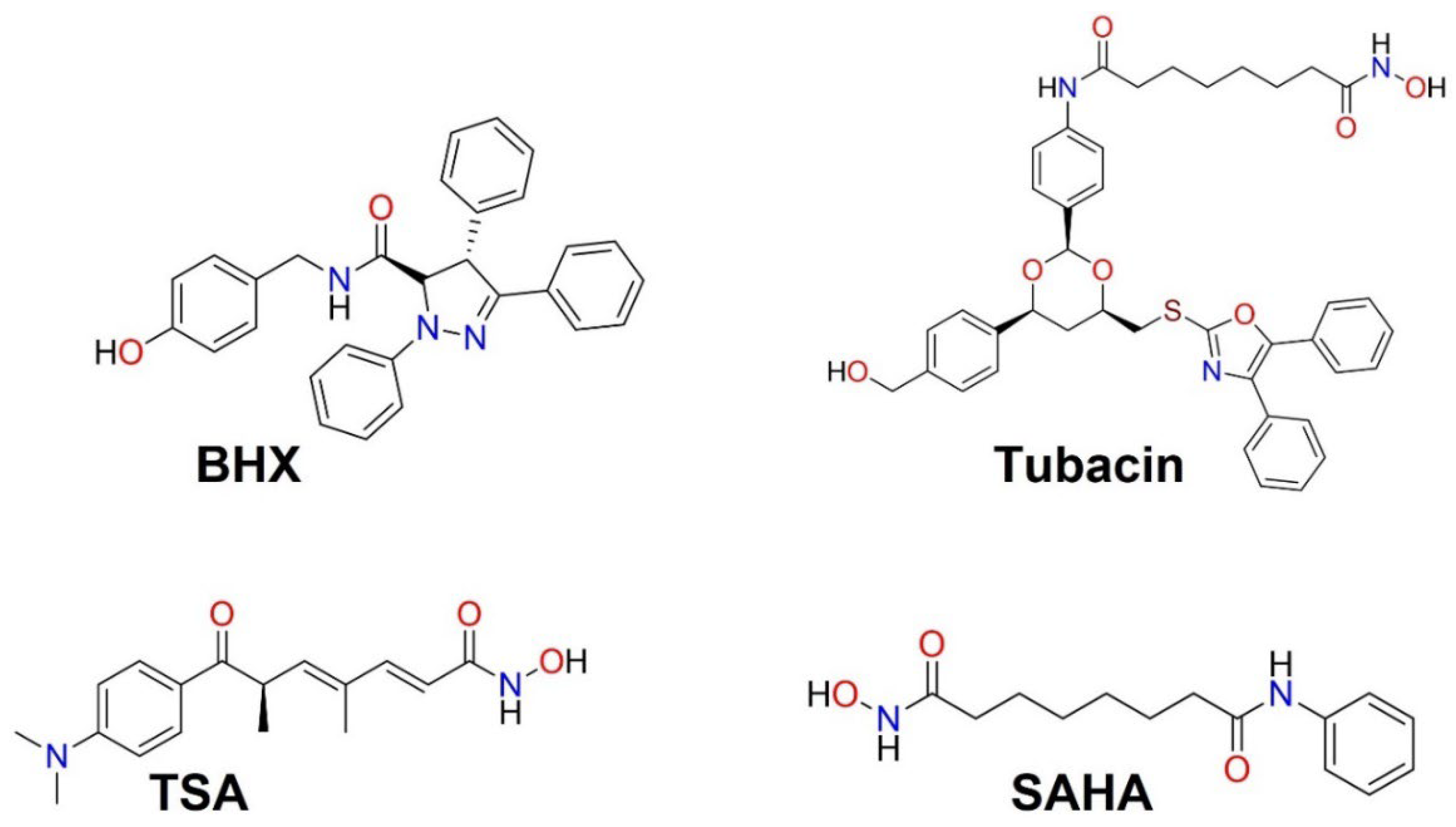

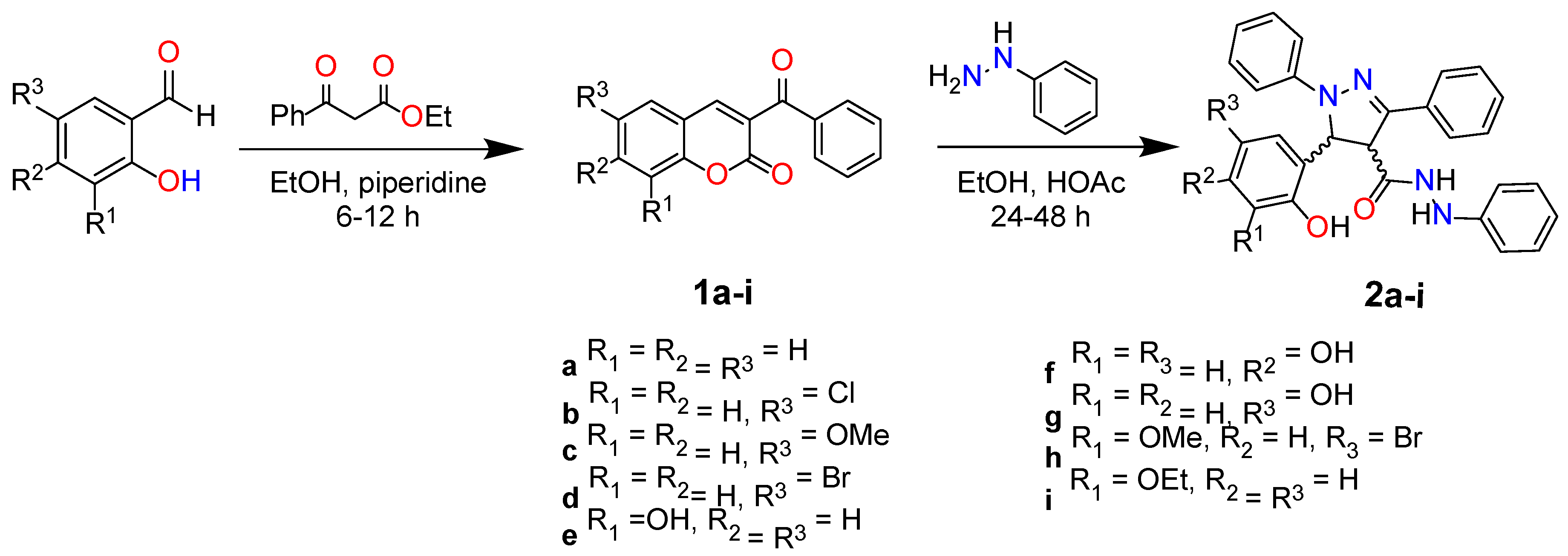
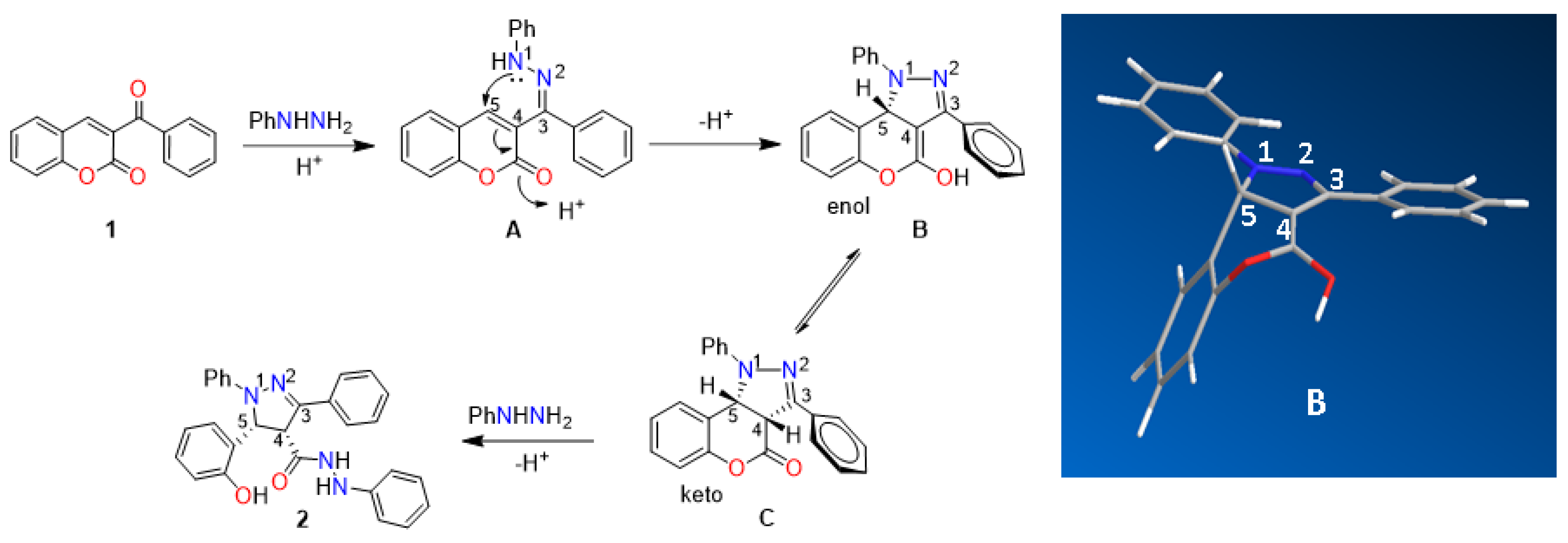
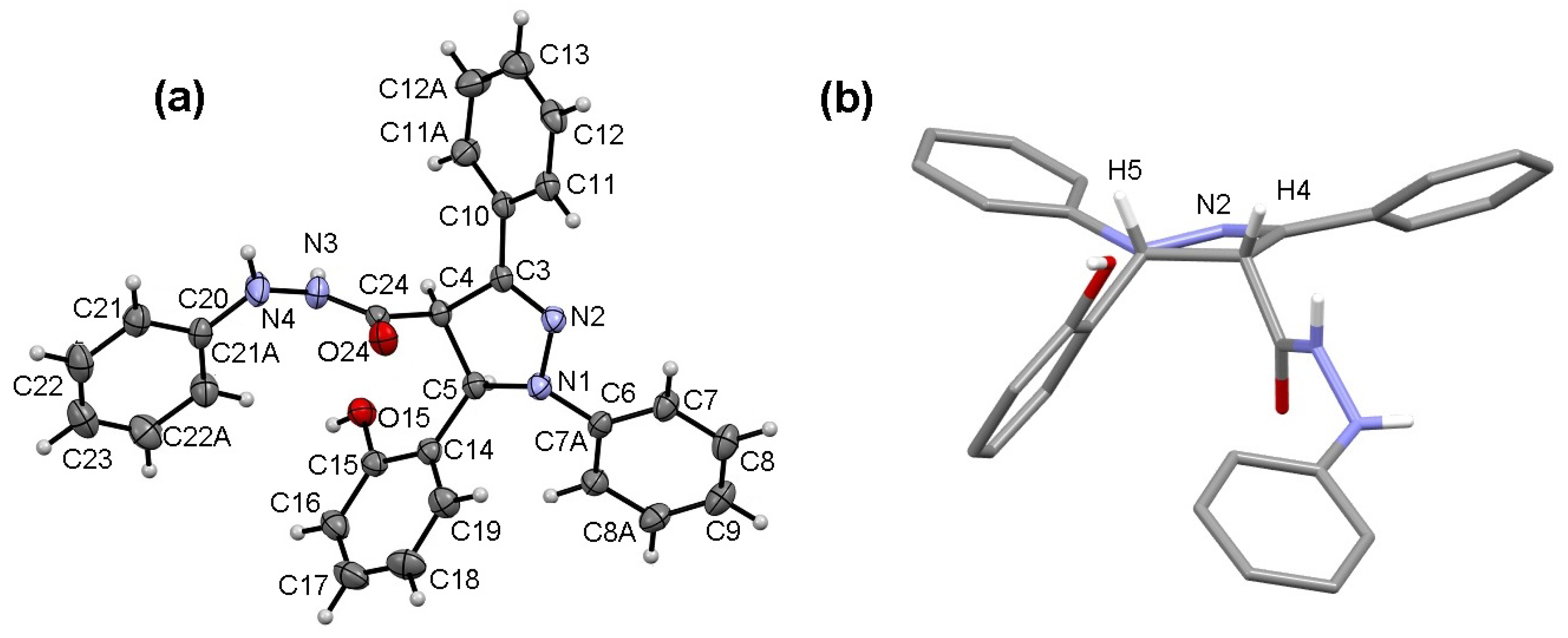
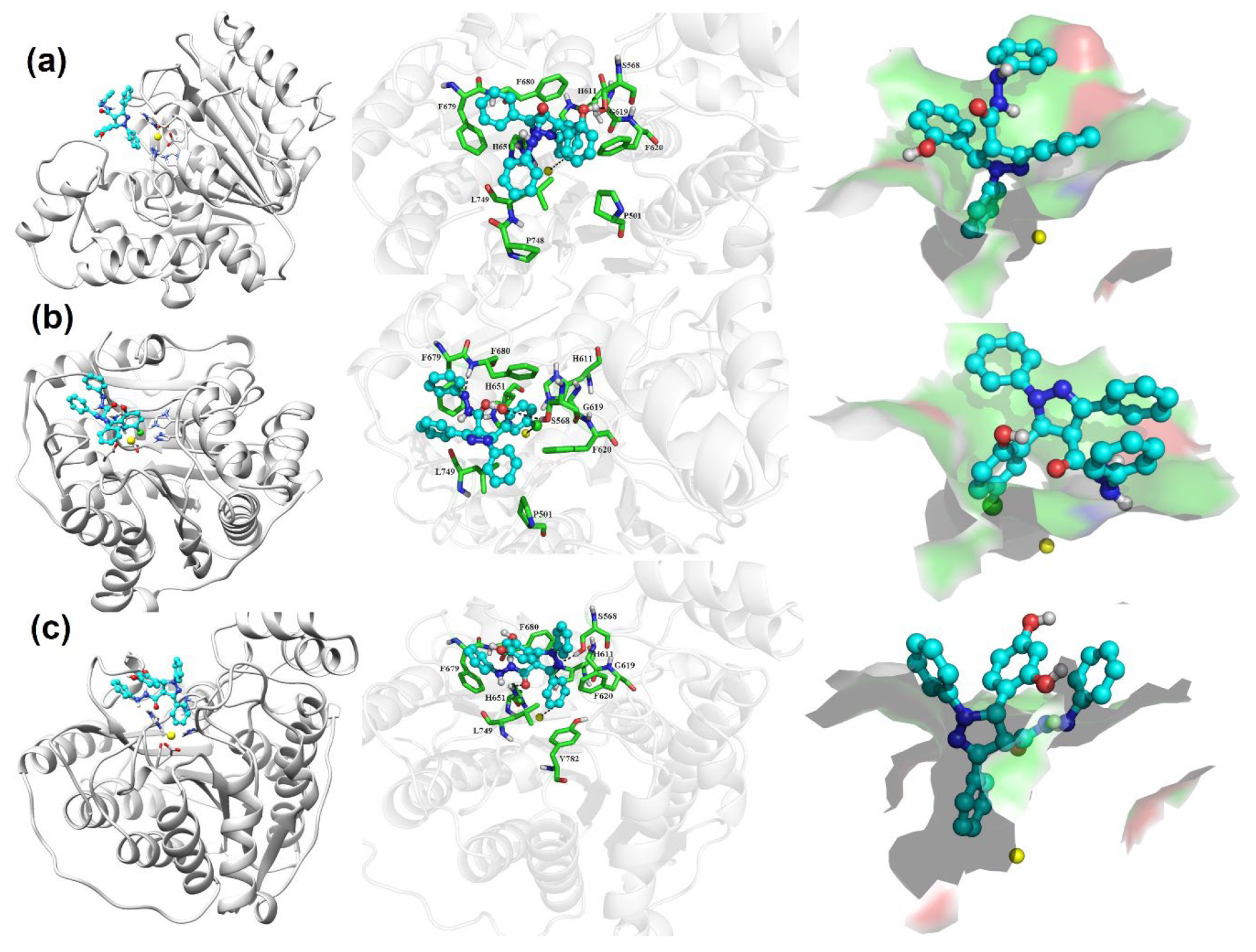
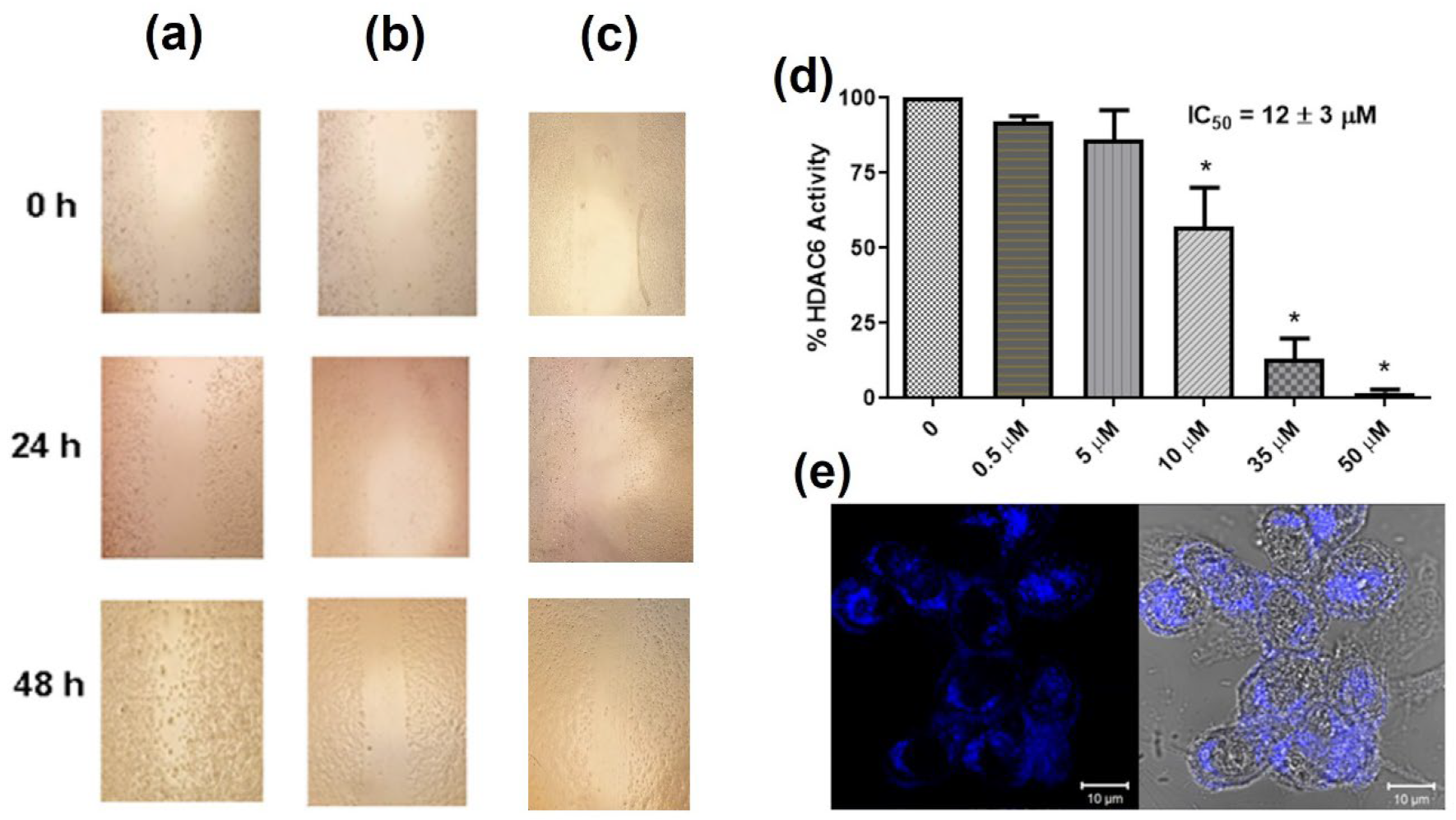
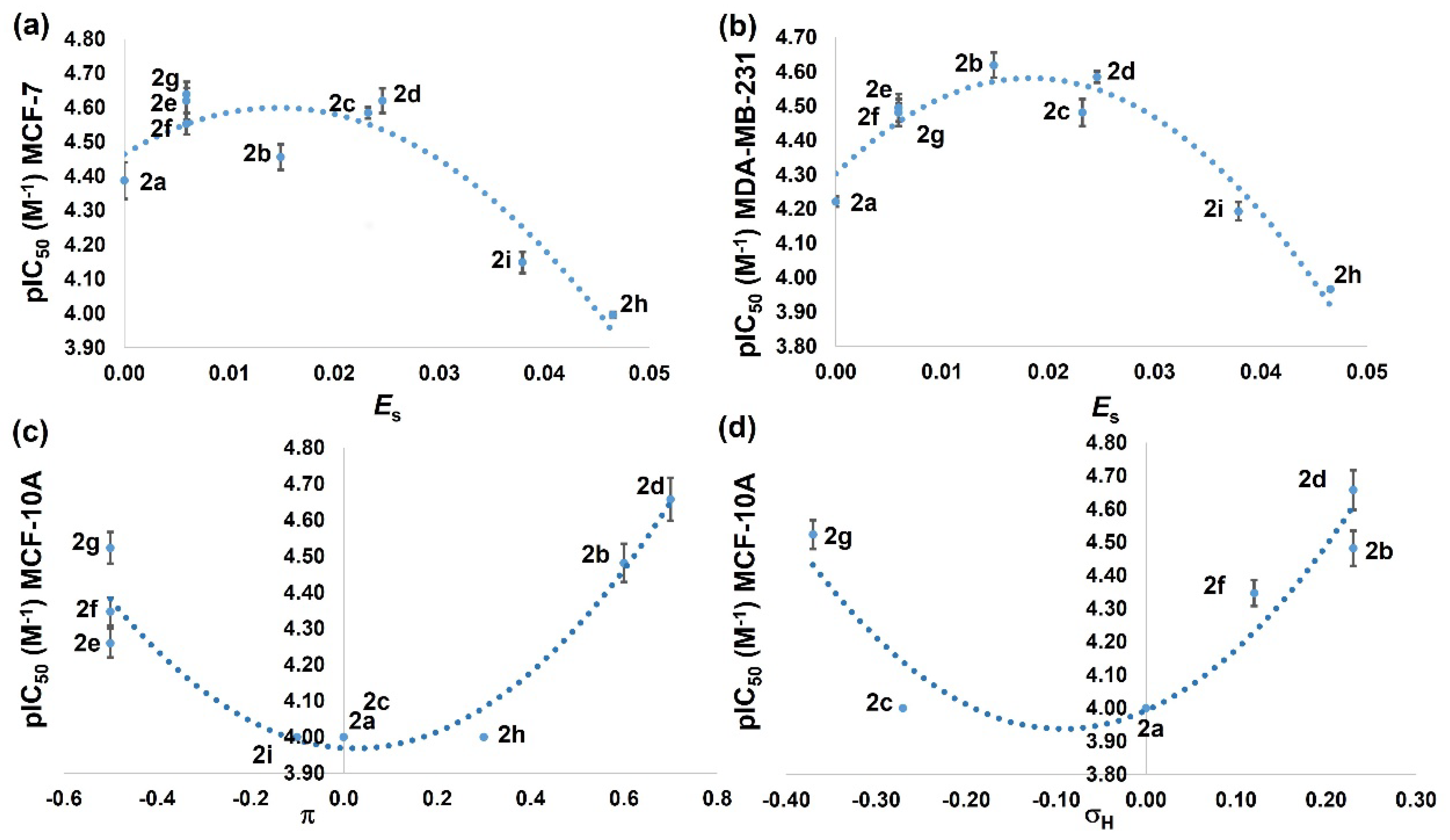
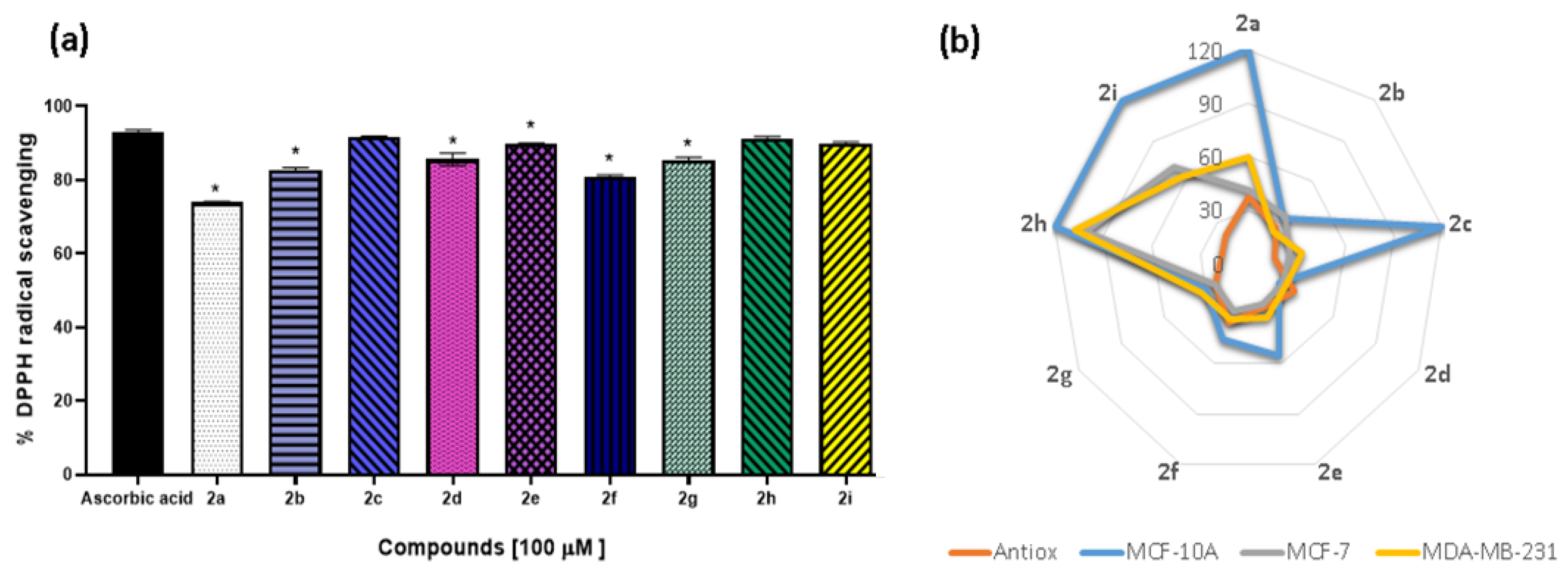
| Comp. | MW | LogP | HA | HD | RB | VLR | LogS | TPSA [Å2] | MR [cm3/mol−1] | %ABS |
|---|---|---|---|---|---|---|---|---|---|---|
| 2a | 448.52 | 2.7 | 6 | 3 | 6 | 0 | −5.0 | 77.0 | 132.1 | 82 |
| 2b | 482.97 | 3.3 | 6 | 3 | 6 | 0 | −5.73 | 77.0 | 136.7 | 82 |
| 2c | 478.55 | 2.7 | 7 | 3 | 7 | 0 | −5.01 | 86.2 | 139.4 | 80 |
| 2d | 527.42 | 3.4 | 6 | 3 | 6 | 1 | −5.83 | 77.0 | 139.8 | 82 |
| 2e | 464.52 | 2.2 | 7 | 4 | 6 | 0 | −4.70 | 97.2 | 133.9 | 76 |
| 2f | 464.52 | 2.2 | 7 | 4 | 6 | 0 | −4.70 | 97.2 | 133.9 | 76 |
| 2g | 464.52 | 2.2 | 7 | 4 | 6 | 0 | −4.70 | 97.2 | 133.91 | 76 |
| 2h | 557.44 | 3.0 | 7 | 3 | 7 | 1 | −5.85 | 86.2 | 147.0 | 80 |
| 2i | 492.57 | 2.6 | 7 | 3 | 8 | 0 | −5.31 | 86.2 | 144.2 | 80 |
| Tubacin | 721.87 | 7.2 | 10 | 4 | 16 | 3 | −9.41 | 168.4 | 200.0 | 51 |
| TSA | 302.37 | 2.2 | 5 | 2 | 6 | 0 | −3.26 | 69.6 | 91.7 | 85 |
| SAHA | 264.32 | 2.3 | 5 | 3 | 8 | 0 | −3.33 | 78.4 | 70.6 | 82 |
| Compounds | MCF-7 | MDA-MB-231 | 3T3/NIH | MCF-10A |
|---|---|---|---|---|
| 2a | 41 ± 5 | 60 ± 2 | >100 | >100 |
| 2b | 35 ± 3 | 24 ± 2 | 19 ± 2 | 33 ± 4 |
| 2c | 26 ± 1 | 33 ± 3 | >100 | >100 |
| 2d | 24 ± 2 | 26 ± 1 | 25 ± 3 | 22 ± 3 |
| 2e | 24 ± 3 | 32 ± 3 | 32 ± 2 | 55 ± 5 |
| 2f | 28 ± 2 | 33 ± 2 | 36 ± 2 | 45 ± 4 |
| 2g | 23 ± 1 | 33 ± 3 | 28 ± 2 | 30 ± 3 |
| 2h | 101 ± 2 | 108 ± 1 | 103 ± 2 | >100 |
| 2i | 71 ± 5 | 64 ± 4 | >100 | >100 |
| TSA | 0.5 ± 2 | 0.4 ± 1 | 1 ± 2 | 0.2 ± 0.06 |
| SAHA | 8 ± 1 | 2.5 ± 1 | 10 ± 2 | 12 ± 1.5 |
Publisher’s Note: MDPI stays neutral with regard to jurisdictional claims in published maps and institutional affiliations. |
© 2022 by the authors. Licensee MDPI, Basel, Switzerland. This article is an open access article distributed under the terms and conditions of the Creative Commons Attribution (CC BY) license (https://creativecommons.org/licenses/by/4.0/).
Share and Cite
Balbuena-Rebolledo, I.; Rivera-Antonio, A.M.; Sixto-López, Y.; Correa-Basurto, J.; Rosales-Hernández, M.C.; Mendieta-Wejebe, J.E.; Martínez-Martínez, F.J.; Olivares-Corichi, I.M.; García-Sánchez, J.R.; Guevara-Salazar, J.A.; et al. Dihydropyrazole-Carbohydrazide Derivatives with Dual Activity as Antioxidant and Anti-Proliferative Drugs on Breast Cancer Targeting the HDAC6. Pharmaceuticals 2022, 15, 690. https://doi.org/10.3390/ph15060690
Balbuena-Rebolledo I, Rivera-Antonio AM, Sixto-López Y, Correa-Basurto J, Rosales-Hernández MC, Mendieta-Wejebe JE, Martínez-Martínez FJ, Olivares-Corichi IM, García-Sánchez JR, Guevara-Salazar JA, et al. Dihydropyrazole-Carbohydrazide Derivatives with Dual Activity as Antioxidant and Anti-Proliferative Drugs on Breast Cancer Targeting the HDAC6. Pharmaceuticals. 2022; 15(6):690. https://doi.org/10.3390/ph15060690
Chicago/Turabian StyleBalbuena-Rebolledo, Irving, Astrid M. Rivera-Antonio, Yudibeth Sixto-López, José Correa-Basurto, Martha C. Rosales-Hernández, Jessica Elena Mendieta-Wejebe, Francisco J. Martínez-Martínez, Ivonne María Olivares-Corichi, José Rubén García-Sánchez, Juan Alberto Guevara-Salazar, and et al. 2022. "Dihydropyrazole-Carbohydrazide Derivatives with Dual Activity as Antioxidant and Anti-Proliferative Drugs on Breast Cancer Targeting the HDAC6" Pharmaceuticals 15, no. 6: 690. https://doi.org/10.3390/ph15060690
APA StyleBalbuena-Rebolledo, I., Rivera-Antonio, A. M., Sixto-López, Y., Correa-Basurto, J., Rosales-Hernández, M. C., Mendieta-Wejebe, J. E., Martínez-Martínez, F. J., Olivares-Corichi, I. M., García-Sánchez, J. R., Guevara-Salazar, J. A., Bello, M., & Padilla-Martínez, I. I. (2022). Dihydropyrazole-Carbohydrazide Derivatives with Dual Activity as Antioxidant and Anti-Proliferative Drugs on Breast Cancer Targeting the HDAC6. Pharmaceuticals, 15(6), 690. https://doi.org/10.3390/ph15060690







